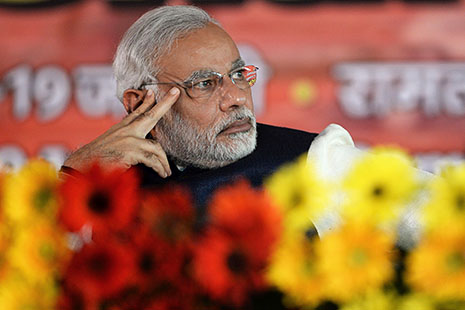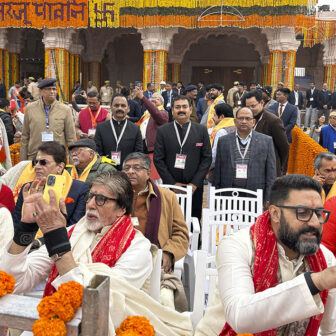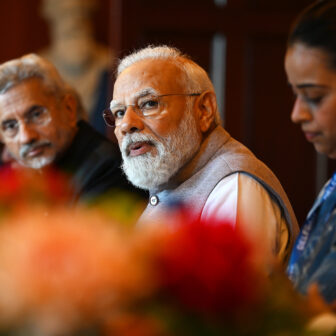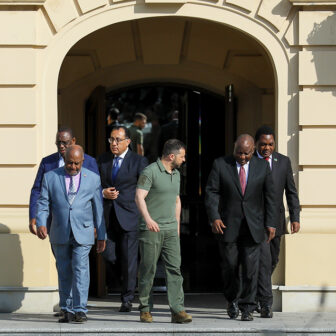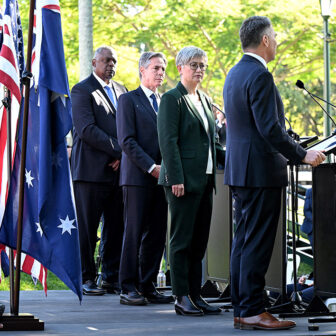Question: When is an Indian political party like an American football team? Answer: When the party is India’s ruling Congress Party and the football team is the Denver Broncos.
The Broncos, you’ll recall, had a record-setting season, but when it came to the Big Game, the Super Bowl, they were the Gang That Couldn’t Shoot Straight. They dropped the ball again and again; they got blown away.
In 2009, the Congress Party returned to power at the head of a coalition government. Although it didn’t have a majority in parliament, the party improved its position and discarded troublesome allies. It appeared well-positioned to propel Indian prosperity and well-being.
Five years later, with general elections due sometime in the next four months, the Congress-led government is poised for a drubbing. It has repeatedly dropped the ball. Or, worse, many would say that it has looked on while someone stole the ball and sold it to a friend. The victim of its own internal structures, the Congress has overseen corruption, incompetence and an abrupt slowing of economic growth.
A laughable example of fumbling occurred recently when a high-caste Congress leader ridiculed Narendra Modi – who will be prime minister if the Bharatiya Janata Party, or BJP, wins the coming elections – as the son of a tea-seller, fit to serve tea at Congress conclaves. Coming from a Tamil Brahmin, a member of one of India’s ancient, highly educated elites, the remark resonated, but not in the way that was intended.
India still rests on foundations of hierarchy and deference, but these attitudes are increasingly resented and challenged. Modi’s supporters celebrated the sneer about lowly tea-sellers with t-shirts proclaiming, “Chai-wala [tea-seller] my PM.” The party set up stalls in cities around the country to give away tea, sell Modi merchandise and deliver political pep talks.
For the Congress Party, the fundamental problem is that prime minister Manmohan Singh has almost no authority in the party or over his cabinet. He is a highly trained and experienced economist with a doctorate from Oxford. He is regarded as honest, and he has kept his family out of public affairs. But he has never won an election and is seen as the creature of Sonia Gandhi, president of the Congress Party. And he sits in the indirectly elected upper house as a representative of the far-northeastern state of Assam. It’s almost as if Tony Blair were appointed to the European parliament to represent Greece.
For structural and cultural reasons, the Congress Party has never managed to dispense with the descendants of Jawaharlal Nehru, India’s first prime minister and a nation-building hero of the twentieth century. That wasn’t how Nehru planned it. But when his successor died unexpectedly in 1966 within two years of taking office, Congress’s leaders, facing a near-famine and a general election, looked for a recognisable symbol to lead the party. They turned to Nehru’s daughter, Indira Gandhi. She’ll be a “dumb doll,” they reckoned, easily manipulated after an election was won.
When Indira Gandhi was assassinated eighteen years later, she left behind a party of obsequious courtiers. The queen was dead, and her panicked courtiers, none of whom had the support to go it alone, turned to her relatives. Indira’s son Rajiv was anointed prime minister and led the party to the biggest election victory in Indian history in 1984.
Five years later Rajiv Gandhi’s government was discredited and defeated. In 1991 he was assassinated by a suicide bomber sent by the Liberation Tigers of Tamil Eelam as payback for India’s role in the Sri Lankan civil war. Today, the key wire-puller and final authority in the Congress Party is Sonia Gandhi, Rajiv Gandhi’s widow, a modestly educated Italian now in her sixties.
An idealised version of the Sonia story goes like this. An Italian girl doing a short course in Cambridge in the 1960s fell in love with an Indian boy. They married; she went to live with him in India. He was an airline pilot; his mother was prime minister. The couple were very happy; they had two lovely children; he flew planes and kept out of politics; she learned Hindi and busied herself with family tasks in her mother-in-law’s house.
Inexorably, though, she was sucked into politics after the assassination first of her mother-in-law and then of her husband. What could she do to honour his memory except serve her adopted country, as the flatterers in the Congress Party kept telling her she must? By 2004, when Congress returned to power at the head of an Irish stew of a coalition, she could have become prime minister, but she wisely chose to install the honest and proven technocrat, Manmohan Singh. Meanwhile, her son, Rahul Gandhi, was pushed into inner councils of the party with a view to his eventually leading it.
This version of the Sonia story focuses on reluctance, self-sacrifice and service to the nation. The negative version contends that there are so many skeletons in the Gandhi family’s closet that the family cannot risk giving up the keys.
Reluctance is an element common to both versions. Although Rahul Gandhi is a member of parliament, he has played little part in legislative politics and has refused to take a cabinet post. If he were to become prime minister after this year’s elections, he would be as untutored in the practices of government as his father was when he became prime minister thirty years ago.
Polite, sophisticated, overseas-trained, Rahul has spent recent years on “party organisation” – efforts to revitalise a political party his grandmother eviscerated forty years ago. If he were a steam train, he would not be Thomas the Tank Engine. Not enough fire in the furnace, many say. Whether his organisational efforts will bear fruit in the long run seems unlikely. What seems probable is that the Congress will not lead the government formed after this year’s election.
THE man who does have steam in his boiler is Narendra Modi, chief minister of the state of Gujarat. Modi works day and night, throbs with political ambition and lives to be prime minister. He claims to run India’s most go-ahead state, where entrepreneurs thrive and villages get uninterrupted electricity.
Modi is not interested in pelf. Though he likes a good meal and a nicely tailored shirt, no one suggests he solicits bribes or condones officials who do. Indeed, he has a reputation for identifying able officers, giving them resources and working them hard.
What interests Modi is power. Last year his party, the BJP, endorsed him as its candidate for prime minister. Modi had endorsed himself years ago.
Through 2013, his state government ran national conferences, involving 5000 or more delegates from around India, on matters of national concern – urbanisation, rural development and similar themes. The delegates were brought to Gujarat, entertained in sparkling conference centres and treated to serious discussions, as well as a speech by Narendra Modi, televised of course. Modi is in his element on the podium; he knows how to use the microphone and the camera and how to hold an audience.
So why isn’t he a shoo-in to lead his party to victory? Because many Indians fear him as an intolerant Hindu chauvinist who permitted one of the worst outbreaks of religiously based killing in India since 1947.
In 2002, a carriage of a train carrying Hindu devotees returning from a pilgrimage was set on fire in a rural station and more than fifty people burned to death. A Muslim gang, it appeared, had set the carriage on fire. It was a ghastly crime and should have resulted in swift arrests. Instead, Gujarat endured weeks of sporadic rioting, in which mobs led by anti-Muslim zealots itching for an excuse murdered more than 800 Muslims; more than 200 Hindus were also killed, according to an official source. Through it all, Modi and his government wrung their hands and did nothing. Indeed, critics say the government egged on the killers. A BJP-led government was in power in Delhi at the time.
Since then, Modi has won three thundering election victories in Gujarat. A substantial section of Gujarat’s Hindu population harbours a visceral fear and dislike of Muslims. (Think Northern Ireland.) Muslims are only 10 per cent of Gujarat’s population.
Today, Modi’s message is about economic development and improving people’s material circumstances. Though his opponents argue that Gujarat’s achievements are grossly exaggerated (primary education and child nutrition rates, for example, are relatively poor), India’s capitalists like the state’s apparent dynamism, its relatively good roads and its reliable power.
India’s English-language media now run a stream of stories speculating about a “Modi wave” and a BJP juggernaut. It is a safe bet, however, that Modi and the BJP will not get the 273 seats needed for a majority in the lower house of parliament. No single party has hit that target for thirty years. The BJP is largely a party of Gujarati- and Hindi-speaking north India. More than half of India does not speak those languages.
India’s leading English news magazine, India Today, which has a soft spot for Modi, ran a recent poll with more than 20,000 respondents around the country. The pollsters performed their alchemy and estimated the BJP and its declared allies would win 212 seats. The Congress Party and its allies would manage only 103. And more than a dozen other parties, many with locally powerful and nationally ambitious leaders, would wrap up 228 seats.
This is where a new entrant on the party scene comes in. The Aam Aadmi (Common Man’s) Party won power in elections to the New Delhi assembly last year. Founded by exasperated citizens pledged to fight corruption and provide honest, hardworking government, it carried great hopes and underlined the almost apoplectic popular frustration with the old politics and politicians. But the old parties have attacked Aam Aadmi relentlessly, and during less than four months in power, its judgement has been called into question and its reputation frayed. By the time national elections are held, its appeal may have waned further.
What sort of prime minister would Modi be? He has run a state of sixty million people for more than ten years and won three elections. But he is a loner, a man who loves a good idea, providing you can convince him he thought of it first. He is used to telling people how high they should jump, not persuading them to jump at all. Could he hold together the immense egos and regional differences that would have to be blended into a BJP-led coalition government? He would not fail for lack of guile or effort.
Elections have not yet been called, and Indian politics have never been more volatile. Today, through the spread of cheap mobile phones, more Indians than ever before get daily information, entertainment and appeals. Much depends on the strength of political organisations in India’s twenty-eight states. Through them, voters will be identified, energised and pestered to vote.
A hung parliament looks likely, with circumstances similar to those in 1996–99 when India experienced three general elections and four prime ministers. But those circumstances may suit Modi and his party if a large and exasperated section of India runs out of options. •
